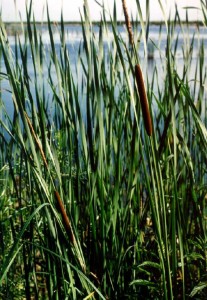Canada’s Lake Winnipeg is the 11th largest lake in the world and it is one of the world’s most polluted lakes. Tinted with a bluish-green tinge as a result of algae, Lake Winnipeg is no longer a viable fresh water source. The key to addressing Lake Winnipeg’s problems is in the Netley-Libau Marsh. Located at the south end of Lake Winnipeg, the marsh filters nutrients running from the red river into Lake Winnipeg. Beginning in the 1970’s, the marsh began to experience significant rises in levels of nitrogen and phosphorus. These elevated levels resulted in a dramatic loss of fish, plants, wild life, aquatic vegetation, and wetland areas.

Richard Grosshans, a researcher with the University of Manitoba and the International Institute for Sustainable Development, thinks he may have the solution to Lake Winnipeg’ s problems. The answer, he says, is cattails. According to his research, preventing harmful nutrients from re-entering the marsh requires removing cattails that grow abundantly in the marsh. While other pollutants, such as nitrogen, are stored in wetlands and are naturally broken down over time, phosphorus gets stored in sediments and eventually retained in biomass, such as cattails. When the cattails decay they release phosphorus into the water.
The research has demonstrated that removing the cattails can help restore the marsh’s ecological potential. In areas where researchers removed cattails, plants began growing two weeks earlier than in areas where cattails were not removed. Additionally, plant size and density in areas where cattails have been removed increased within two years of removal.
Grosshans’ project also works to turn the removed cattails into fuel pellets so that they can be used as a renewable source of energy that can replace fossil fuels and reduce the use of coal. By using the cattails as a biofuel, Grosshans hopes to reduce pollutants in Canada’s natural water ways, restore the marsh’s habitat, and reduce green house gas emissions. While more research needs to be done to assess the environmental impact of harvesting a wetland’s biomass, Grosshans’ PhD advisor Nazim Cicek remains optimistic about the project’s potential. “It is a bit of a perfect storm, as far as looking at green energy and greenhouse gas mitigation, while at the same time addressing the largest fresh water concern in the province,” he told producer.com last year. Grosshans continues to look for the best way to convert cattails into biofuels and researchers are currently working with a manufacturing company to see if they can turn the cattails into mixed fuel pellets.
Similar projects that look as cattails as an alternative energy source are under way in the United States and Europe. In North Carolina researchers at the Agricultural and Technical State University are converting cattails into ethanol to bring down the price of fossil fuels. In Latvia, Finland and Estonia , cattails are already being harvested and then burned as a heat source.
By Graham Salinger. He is a research intern for the Nourishing the Planet project.

Danielle Nierenberg, an expert on livestock and sustainability, currently serves as Project Director of State of World 2011 for the Worldwatch Institute, a Washington, DC-based environmental think tank. Her knowledge of factory farming and its global spread and sustainable agriculture has been cited widely in the New York Times Magazine, the International Herald Tribune, the Washington Post, and
other publications.
Danielle worked for two years as a Peace Corps volunteer in the Dominican Republic. She is currently traveling across Africa looking at innovations that are working to alleviate hunger and poverty and blogging everyday at Worldwatch Institute’s Nourishing the Planet. She has a regular column with the Mail & Guardian, the Kansas City Star, and the Huffington Post and her writing was been featured in newspapers across Africa including the Cape Town Argus, the Zambia Daily Mail, Coast Week (Kenya), and other African publications. She holds an M.S. in agriculture, food, and environment from Tufts University and a B.A. in environmental policy from Monmouth College.








